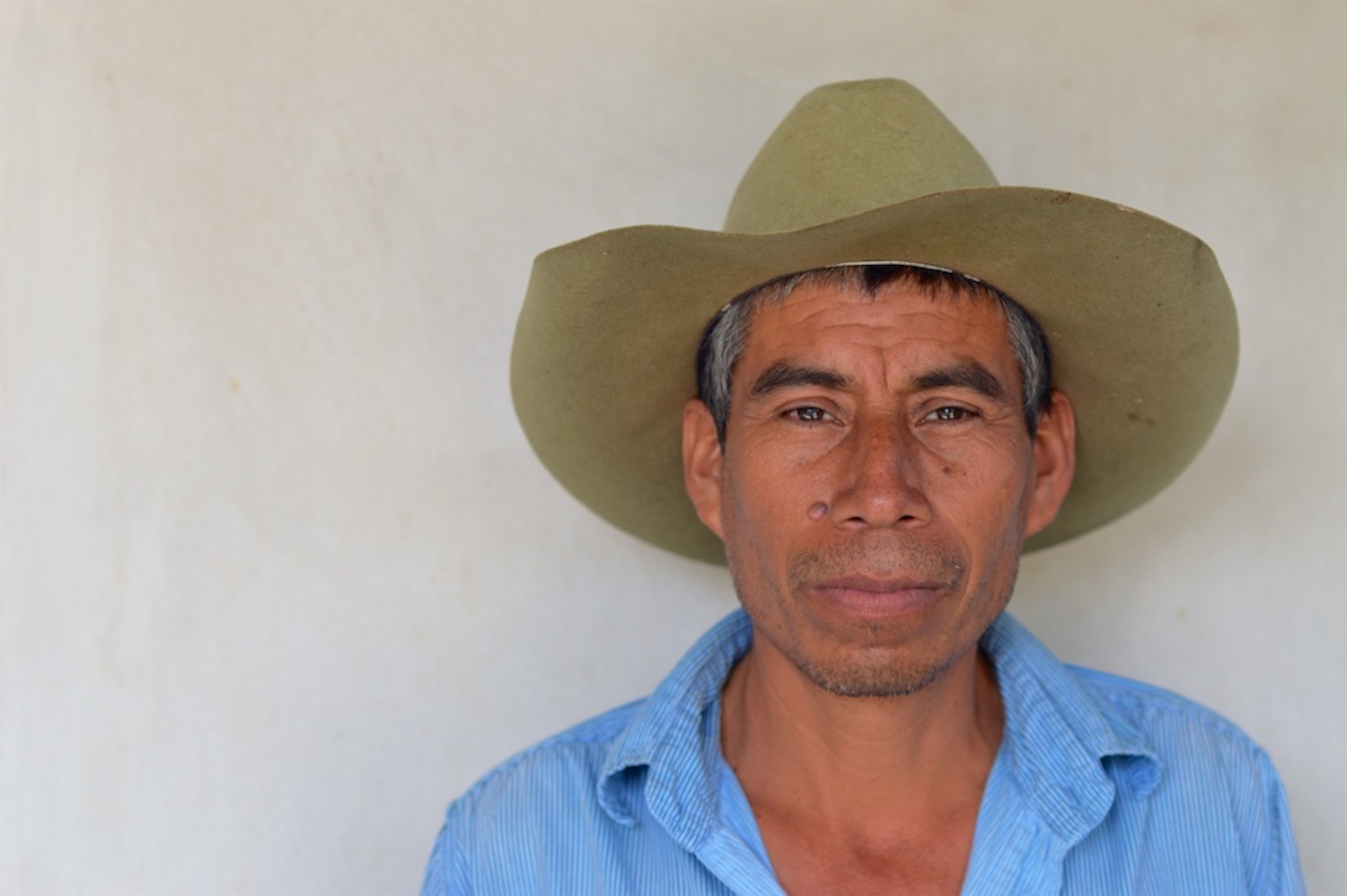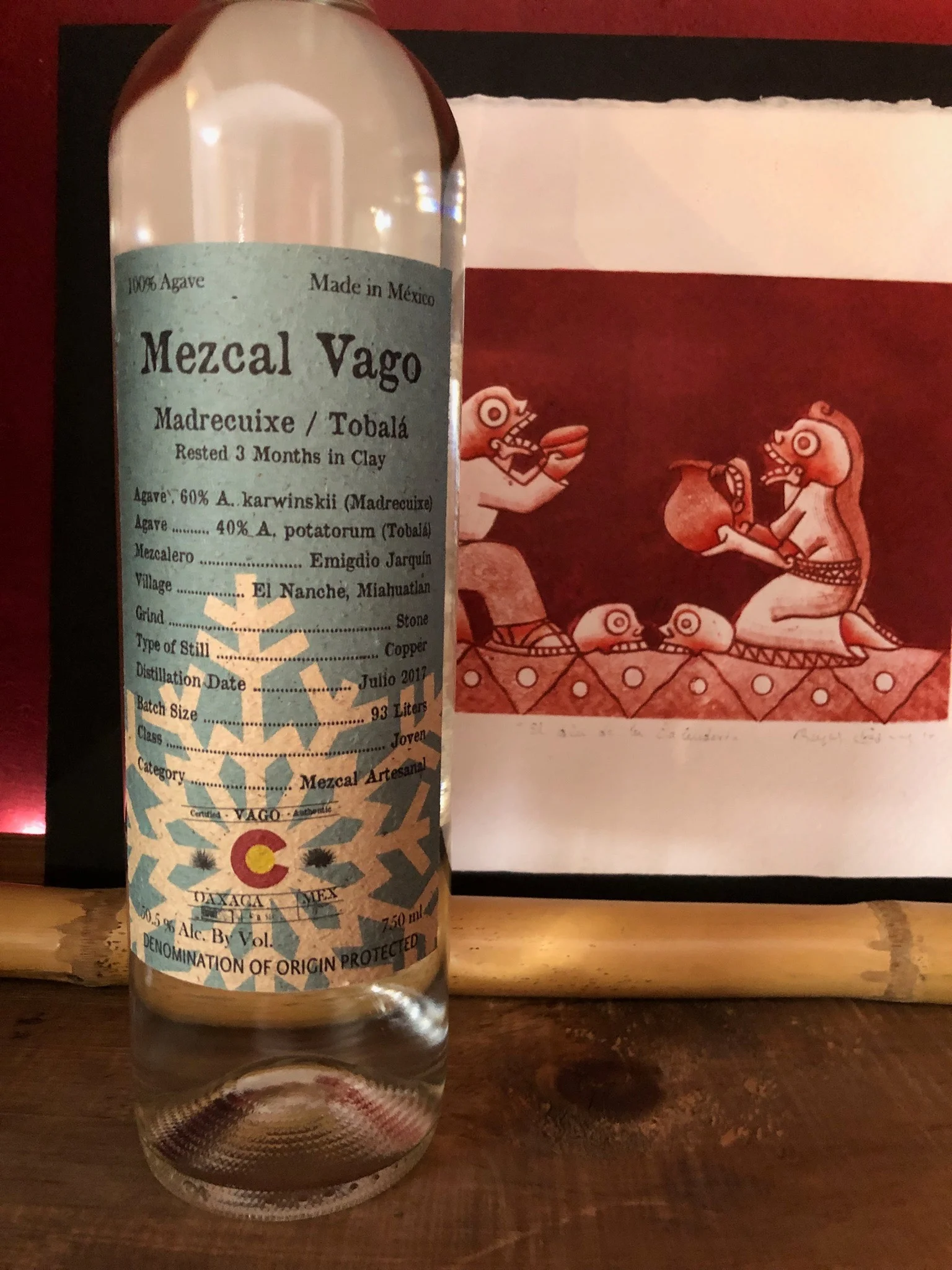Ensamble de Emigdio Batch E-02-CET-18
Mezcal Vago is excited to release our first batch of ensamble from Emigdio Jarquín. For his inaugural 170-liter batch of ensamble for Mezcal Vago, Don Emigdio selected a blend of wild Cuixe, cultivated Espadín, and wild Tepezate selected from the Chamizal and El Pochotle plots near his palenque in El Nanche, Miahuatlán (16°23'51.4"N 96°33'03.5"W).
Over February 19th, 20th, and 21st, Don Emigdio harvested 128 Cuixe plants weighing 1,125 Kg, 8 piñas of Espadín weighing 840 Kg, and 13 piñas of Tepeztate weighing 442 Kg. He roasted them for six days in an earthen bit, beginning on February 23rd. On March 8th, he began crushing them by way of tahona. The begazo fermented dry for two days before 378 liters of well water was added to the fermentation and the batch was fermented for four more days. This resulted in 2,608 liters of tepache, or must. The first distillation yielded 460 liters of ordinario at 22.4% ABV. The ordinario was then distilled a second time over June 16th and 17th, resulting in a final still-proof batch of 138 liters of mezcal at 62.4% ABV. For those keeping score at home, that is 17.44 Kg of raw agave per liter of mezcal.
To refine this batch, 28 liters of distilled well water were blended with the first 7 liters of colas (tails) at 42.4% ABV to produce a blend of 35 liters at 8% ABV. The cola/water blend and mezcal were both rested for one month before being blended together on April 19th to produce a bottling batch of 170 liters at 51.39% ABV.
Agave Cuixe
What we have called Cuixe (pronounced cuishe) in the past is referred to as Bicuixe in the region surrounding Miahuatlán de Porfirio Díaz. When speaking with our mezcaleros, we typically refer to the agave using whatever regional term they are accustomed to, but to avoid confusion among consumers, we have tried to remain consistent when it comes to bottling. As such, although this label says Cuixe, Emigdio knows it as Bicuixe. Regardless of what it is called, it is a member of the Agave Karwinskii family. Karwinskiis are quite unique in that across the several sub-varieties that exist, they all grow on stalks that can reach up to 4 feet tall with the rosette or piña growing on top of the stalk, resulting in a plant that can reach heights of up to 7 feet. Agave in the Karwinskii family can often take between 15 and 18 years to mature.
Between the different sub-varieties, there are different ratios of stalk to piña which can affect the final flavor. The starches in the stalk are structured differently, such that they do not always break down during the roasting process. As a result, in sub-varieties like Cuixe, which have more stalk in relation to the piña, this can result in mezcales that do have a core of agave sweetness that most are used to, but there is an overall dry and starchy quality to the mezcales that can linger on the palate. Madrecuixe typically has a larger piña than Cuixe, resulting in mezcales that do have that starchy, grassy note often associated with Cuixe, but with a touch more sweetness and body. One reason that Madrecuixe is so named is that they often grow as solitary plants surrounded by several Cuixe, as though they are protecting, or a “mother” (madre) plant. However, the Cuixe are not part of the Madrecuixe.
The distribution of Agave Karwinskii can be seen in the map below:
Image taken from CONABIO website
Agave Tepeztate
Known variously as du- cual (Zapotec), pitzomel (Nahuatl), de caballo, curandero, becuelo, and others, Agave Tepeztate (a. Marmorata) are some of the most prized agave for producing mezcal. Renowned for their unique appearance and delicate flavors, these agave produce some of the most floral and readily identifiable mezcals. Often growing directly out of rock cliff faces, like Tobalá these agave have a propensity for growing in very difficult and inaccessible locations, making harvesting these unwieldy behemoths notoriously difficult. At the upper end of the spectrum, these agave can weigh around 200 kg, or 450 pounds at the time of harvest! The aromatic high tones to these mezcals can be partially attributed to their lower starch content compared to varieties like Espadín and Coyote. When approaching maturity these agave will often absorb more water than most, further diluting their starch content, reducing the mezcalero's yield and elevating the floral qualities and light finish of these prized mezcals. Despite being seemingly delicate in nature, Tepeztate have some of the most complex, long-lasting finishes in the mezcal world; finishes that continue to evolve over a long period.
Aquilino harvesting wild Tepeztate
While some mezcaleros say that Tepeztate can take up to thirty-five years to mature, the Tepeztate of Don Emigdio and Don Aquilino typically take between fifteen and twenty years before they are ready to harvest. However, Aquilino has been able to harvest cultivated Tepeztate in as little as seven to ten years. In 2016 Aquilion planted around 450 Tepeztate plants, with an eye to plant even more in 2017. The distribution of Tepeztate is represented by the green shading in the map below:
Image taken from CONABIO website
Agave Espadín
spadín typically takes 7 – 12 years to mature, reaching roughly 5 – 6 feet in diameter and 4 feet in height. The rosette has very straight, narrow pencas with a gray-green hue and small spines. Once the pencas have been removed, the piña of a mature espadín can weigh around 100 kilograms.
The genetic “mother” of a. Tequilana, a. Angustifolia var. Haw, or “Espadín,” is the most prolific species of agave used in mezcal production. The plant grows prevalently throughout Oaxaca but its range extends between both the north and south borders of Mexico. The plant is very disease resistant, has a large yield of mezcal produced per kilo of agave harvested (due to high sugar concentrations) and has a shorter maturation time compared to most other agave used for distillation. The plants can be easily cultivated and are able to reproduce clonally; all of these factors combining to allow a. Angustifolia to dominate the mezcal market. Almost every brand of mezcal begins by bottling an Espadín and it is usually the first one that consumers experience; both because of its availability and price point. 77.4% of mezcal produced in 2014 was from a. Angustifolia. The geographic range of a. Angustifolia can be seen in the map below:
Image taken from CONABIO website
Image taken from CONABIO website
Emigdio Jarquín Ramirez
Emigdio distills outside of Miahuatlán de Porfirio Díaz. We are very proud and excited to have finally found a mezcalero from this area we can put in a Vago bottle. Miahuatlán is a historically important town in mezcal production as well as where both Aquilino and Tío Rey’s families emigrated from. By adding Emigdio to the family, we are able to extend the conversation of our history and tradition even further back in time.
Emigdio’s land is in the Nanche district of Miahuatlán de Porfirio Diaz, about 2 ½ hours directly South of Oaxaca City. The palenque sits at around 4,970 ft., among gently rolling hills and shallow arroyos in a semi-arid climate. In the surrounding area grows Agave Espadín, Mexicano Verde, Tobalá, Tepeztate, Arroqueño, Pulquero, Madre Cuixe, and Bicuixe (Cuixe).
Mezcal goes back in his family at least three generations, Emigdio having learned it from his grandfather. Their horno is a conical pit dug into the earth, which can hold up to 7 tons of Espadin. Emigdio usually roasts his agave for 5-7 days, which is on the longer end of an average roast. He then lets it rest in the sun to cool for one to two weeks.
They use a cement tahona lined with rocks and pulled by mule to crush their agave. Once crushed, they use four Ocote wood fermentation vats with volumes of 1,470, 1,600, 1,600, and 1,700 liters, which usually take around three days to ferment to completion.
Distillation is done in a 300 l. copper refrescador still. Refrescador is a technique that is common to the area surrounding Miahuatlan, but Vago has never used before. The still looks similar to a copper alembic still with a stainless steel cylinder surrounding it. This cylinder is then filled with water, allowing it to cool the upper part of the still. This upper chamber now acts as a condenser and sends the alcohol vapor back down into the boiler before being heated again and passing out of the still and into the condensing coil. This method essentially allows for two distillations during a single pass through the still. Cuts are made using a carrizo to test for ABV as well as taste and smell. A full capacity 300 l. still will produce, on average, 100 l. of mezcal in roughly 14 hours.
A full roast of 700 tons will produce up to 700 l. of mezcal depending upon the which agave is being used. ABV is then adjusted by using colas that have been rested with distilled water in order to preserve taste and mouthfeel. Like all Vago mezcal, Emigdio’s goes through a simple sediment filtration through a tubular cellulose filter before bottling. The bottling is done by hand in Oaxaca City. The very light filtration is the only way the mezcal is affected between when it was made on the palenque and how it ends up in the bottle.




















